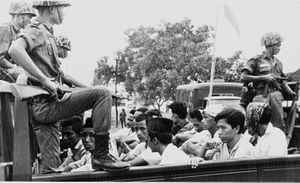Museums and history books rarely factor into presidential politics. But as Indonesia’s presidential election approaches, they have become sites of political anxiety. All of this is due to the ongoing legacy of the Suharto regime’s 32 years of political manipulation. Two decades into the democratic restoration known as “Reformasi,” the shadow of the dictatorial New Order still darkens public discourse on crucial aspects of Indonesian history.
As a historian researching Southeast Asian Cold War museums, I inadvertently stumbled into this still hotly contested terrain.
Museums and the New Order Narrative
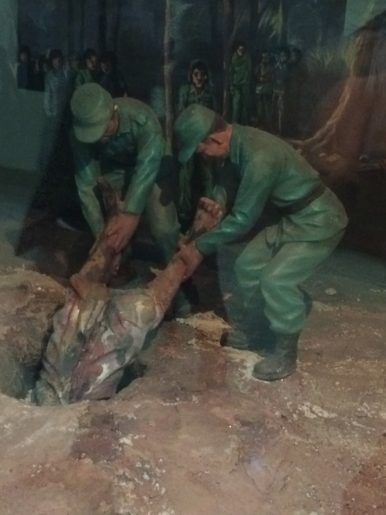
A miniature diorama of rebel soldiers throwing a murdered officer in a well at Lubang Buaya in the early hours of October 1, 1965. Photo by Michael G. Vann.
On the night of September 30-October 1, 1965, a bungled coup attempt by disgruntled mid-level officers resulted in the death of six generals, a lieutenant, and the one surviving general’s young daughter. A faction of rabidly anti-communist officers, led by Suharto, used the murders as a pretext to launch a campaign to destroy the Indonesian Communist Party (PKI). Within six months, the Indonesian National Army (TNI), working with allied religious organizations and criminal gangs, slaughtered upwards of a million PKI members and fellow travelers, the vast majority unarmed civilians. A larger number of party members, union organizers, feminists, intellectuals, and family members were detained for over a decade in brutal conditions in island prisons such as Pulau Buru. Even after release, they suffered legal and social discrimination as their identification cards were marked “EKS-TAPOL” (“former political prisoner”).
To justify the bloodshed and his insubordinate seizure of power, Suharto promoted the myth that the People’s Republic of China was arming a massive PKI militia in preparation for a communist takeover. For the next generation, the New Order used this lie and the dark fantasy that an underground PKI might seek revenge to legitimize military rule and the Suharto family’s kleptocracy. Only Suharto and the TNI could protect the nation from the ongoing threat, the narrative went.
An array of propaganda tools — including annual ceremonies, required film viewings, and street naming — repeated the story of the martyred generals and the alleged danger of the PKI plotting in the shadows. Suharto established the Pusat Sejarah TNI, the Army History Center. Run by loyalists from the officer corps, the Pusat Sejarah TNI published official histories of the alleged coup and opened two major museums, Museum Pengkhianatan PKI (Komunis) (“the Museum of the Indonesian Communist Party’s Treachery”) in the Pancasila Sakti (Sacred National Ideology) monument complex at Lubang Buaya (“Crocodile Hole”) and the Satriamandala Museum.
Located on the site where the murdered generals’ bodies were literally thrown down a well, the former presents the history of the PKI as a long-term threat to Indonesia. Dozens of miniature and life size dioramas depict conspiratorial PKI meetings and violent direct actions such as land seizures, attacks on mosques, and menacing demonstrations. A bilingual sign marked “clothing and traces of blood” directs visitors to the “Room for relics and other historical effects,” which houses photographs of the victims, their personal effects (some marked “replica”), and the blood-stained clothing they were wearing when they were killed.
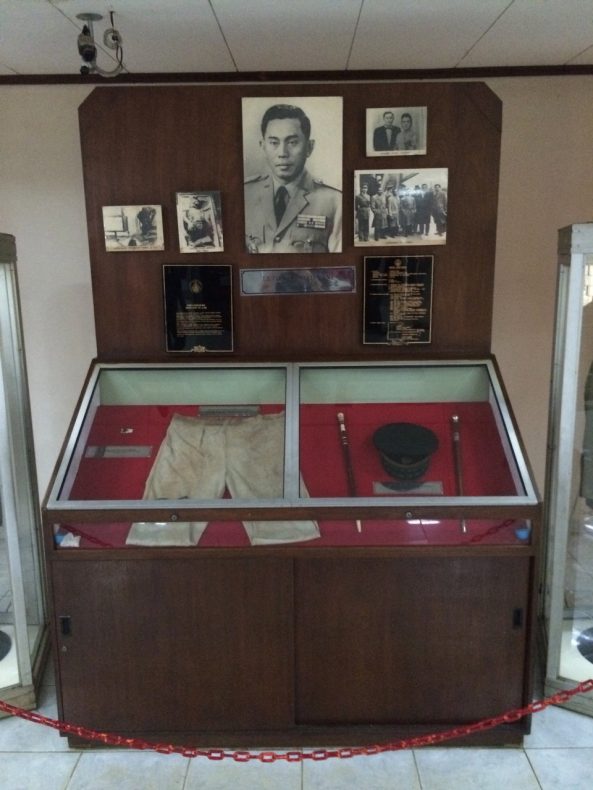
Display of General Ahmad Yani’s personal effects, including the blood stained pants he was wearing when murdered. One of the photos is from a 1984 docudrama and not an original image. Another graphic photo is his exhumed body. Photo by Michael G. Vann.
As the name suggests, the museum’s ideological message is heavy handed. The graphic violence of the displays leaves little room for nuance. Importantly, the narrative stops with the funeral for the martyred officers on National Armed Forces Day, October 5, 1965. There is no discussion of the subsequent anti-communist slaughter and mass incarceration. Indeed, aside from Balinese activist I Gusti Ketut Agung’s privately owned Taman 65, there are no memorial to the victims of one of 20th centuries greatest politicides.
Satriamandala (which can be translated from Sanskrit as “A Sacred Place for Knights”), opened in 1972, tells the history of the TNI from its beginnings under Japanese supervision during the Pacific War through military campaigns and relief missions in the 1990s. It houses an impressive collection of weapons, photographs, dioramas, statues, and historical artifacts. Outside, the grounds contain tanks, planes, helicopters, artillery pieces, an armored personnel carrier, and a patrol boat. In 1987, a new wing was opened. Drawing from Javanese, Waspada Purbawisesa can be translated as “Museum of Eternal Vigilance.” Set apart from the main buildings, this structure houses a research library on the upper floors. But the main drawn has been the dozens of dioramas on the second floor devoted to TNI actions against radical Islamist groups. They depict military campaigns against the widespread Darul Islam rebellion of the 1950s, the 1981 high jacking of Garuda flight 206, and the 1985 bombing of Borobudur.
Surprisingly, major events such as the fall of the Berlin Wall in 1989 and of Suharto in 1998 did not lead to revisions of either museum. Suharto expanded the Museum of PKI Treachery in 1992. In 2013 a new wing with life size depictions of the death of Ade Nasution was added. Elsewhere in Jakarta, in 2008 Nasution’s home became a museum, following the precedent of turning General Ahmad Yani’s home into a museum on October 1, 1966. In the Yani home a roped off plaque marks the exact spot of the general’s death. Without a new national narrative, Reformasi Indonesia has clung to the New Order mythology.

In the Ahmad Yani Museum, visitors can see the spot in which the general bled to death. Liquor bottles and wine glasses have recently been removed from the bar, and a poster covers up an alcohol themed mural. Artificial flowers and other mementos further disguise the bar. Photo by Michael G. Vann.
A Year of Visiting Museums Dangerously
For decades, both museums welcomed tens of thousands of visitors a year, the vast majority school children on patriotic field trips. While the occasional foreigner might make it to Satriamandala as it is not far from a neighborhood with many expats, few venture out to the suburban Lubang Buaya site. On my various visits over the past decade I’ve been the subject of much friendly curiosity and asked to pose in dozens of selfies and group photos.
However, in November 2017, I was denied entry to Lubang Buaya. A laminated sign stated that “for a moment, visitors from abroad are not allowed to enter/visit Pancasila Sakti Monument before having permit from headquarter [sic.].” Confused by this, especially as a bus load of school children was allowed in, I asked the guards for clarification. Embarrassed by the situation, they tried to be helpful. I persuaded them to show me the orders and let me speak to their equally embarrassed superior officers. Later in the day, I visited the Nasution Museum but the atmosphere was decidedly tense. An armed soldier escorted me through the site and inexplicably denied me access to a room displaying a collection of antique guns. Unlike previous visits where I was encouraged to pose next to a life size statue of Ade dying in her mother’s arms, selfies were out of the question. At the Yani home and Satriamandala, the museum staff politely but firmly denied me access, even as another boisterous group of school children entered the military museum.
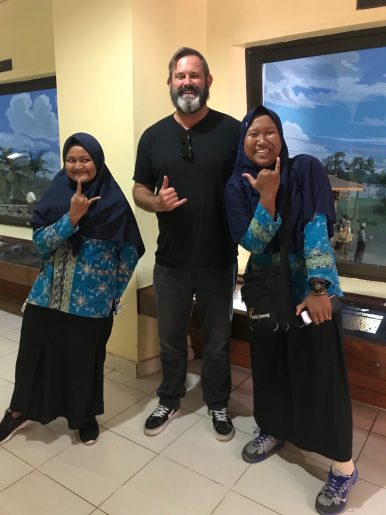
Even in front of some of the most gruesome displays of alleged PKI violence, most visitors are in a festive mood and eager to grab a photograph with the rare foreign visitor — when foreigners are permitted to enter, of course. Photo by Michael G. Vann.
Having just started a major research project on depictions of violence in Southeast Asian Cold War era museums, I continued to press the issue. Officials in the office of the director of museums were perplexed by the news and assured me that I should be able to enter. However, a few phone calls to the TNI headquarters confirmed the foreigner ban and seemed to visibly annoy the civilian staff. After leaving my card in several offices, I received a JPEG of the secret order from an anonymous email account. Evidently, on February 21, 2017 Major General Benny Indra Pujihastono of military intelligence circulated a memo barring foreign nationals from TNI museums. Later I was told that if the American Embassy in Jakarta could provide a “security clearance” I could visit these public museums. Embassy officials had no idea what I was talking about. As I brought the matter to the attention of the international community of scholars of Indonesia on social media, the consensus was that several recently published and forthcoming books on the violence of 1965-1966 had made the TNI nervous about the museums’ dated ideology. After weeks of dead ends, I gave an interview to a local journalist. When the article was published, the TNI quietly rescinded the decree.
Meanwhile, Indonesian national politics were increasingly embroiled in a contrived scandal in which Basuki Tjahaja Purnama (“Ahok”), then the governor of Jakarta and an ally of President Joko “Jokowi” Widodo, was alleged to have profaned Islam. Despite the video evidence being clearly edited, massive demonstrations paralyzed the capital and Ahok, an ethnic Chinese and a Christian, was convicted of blasphemy.
Anti-Ahok activists conflated Islamic identity politics with Sinophobia and anti-communism. As the nation entered into the 2019 election cycle, social media rumors and other forms of fake news claimed that Jokowi himself was PKI. Suharto’s New Order mythology was once again casting its shadow over the nation.
Raided Liquor Cabinets and Book Stores
When I returned to Jakarta in January 2019, there was no problem entering the museums. However, I found a number of subtle and not-so-subtle changes in the displays. At Lubang Buaya, the diorama of the murder of Ahamd Yani had been altered. Hailed as a true hero of the night of September 30, Yani is said to have given the kidnappers a dressing down, slapped one, and slammed the door in their face, only to be shot in the back through the glass door. He bled to death on the floor in front of his well-stocked bar. As his death was made famous in the state commissioned four-and-a-half hour docudrama, many Indonesians have seen Yani’s bar. A classic example of mid-century interior design, the bar has a stylish mural depicting a wine decanter and other drinking vessels.
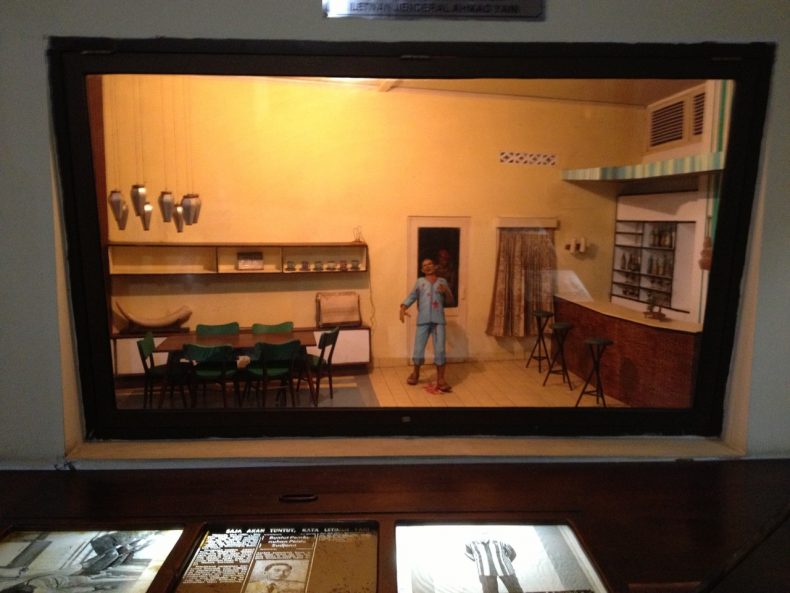
A miniature diorama of General Ahmad Yani’s murder. Shot in the back through a glass door, the general died on the floor in front of his well stocked bar. This photograph was taken in 2013. Photo by Michael G. Vann.
Sadly for the deceased general, his bar has been raided. At Lubang Buaya, the miniature liquor bottles have been pulled from the diorama. In the Yani home, not only is the bar dry but the mural has been awkwardly covered up with a poster-size reproduction of his daughter’s hagiographic biography, Profile of a Soldier. The bar itself is cluttered with artificial flowers, a bust, and various mementos in an amateurish effort to hide its real purpose. Evidently, despite the widespread knowledge that the macho soldier enjoyed a good drink, the museums have been purged of alcohol so as not to offend Islamic sensibilities.
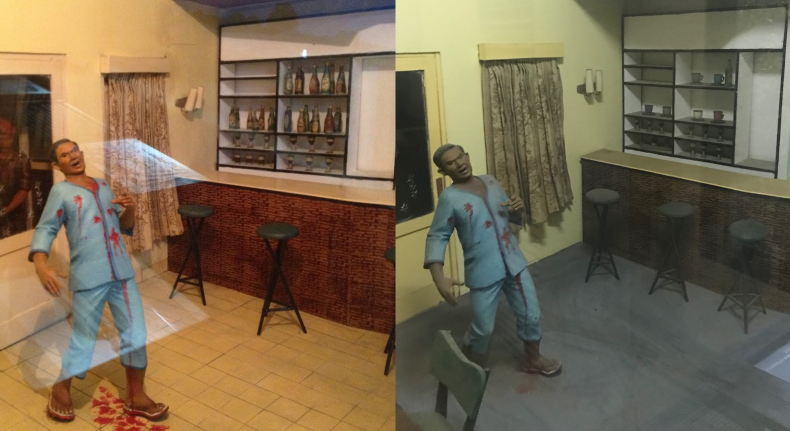
The photo on the left, taken in 2013, highlights the miniature liquor bottles visible in Yani’s bar. In the photo on the right, from January 2019, his bar has been purged so as not to offend Islamic sensibilities. Photos by Michael G. Vann.
At Satriamandala, the concessions towards Islamic identity politics go much further. While once again open to Indonesians and foreigners, the Waspada Purbawisesa building is closed to all. When I visited the site on a Thursday afternoon, I found the front door unlocked but the lobby and reception unstaffed. As I ventured upstairs, I discovered the second floor to be in a state of disrepair with most of the lights turned off. About half of the dioramas and their accompanying bilingual explanations depicting the TNI campaigns against Islamist rebels and terrorist organizations had been removed. Evidently, the commemoration of anti-Islamist military campaigns is not appropriate for the contemporary political climate.
Meanwhile, outside of the museums, in January 2019 TNI officers led raids on bookstores. First in Padang, West Sumatra, and then in Kediri, East Java, and Karakan, North Kalimantan, soldiers seized titles related to the history of the 1960s. Both the TNI and the national Attorney General’s Office have suggested much larger raids throughout the archipelago, claiming that the books promoted communism and could revive the PKI. Anyone who has read the books in question would challenge this interpretation. That the books are not formally banned by the government makes these arbitrary raids even more worrisome.
As the nation moves toward a hotly contested election, paranoia over the New Order’s historical narrative is alive and well in Indonesia.













